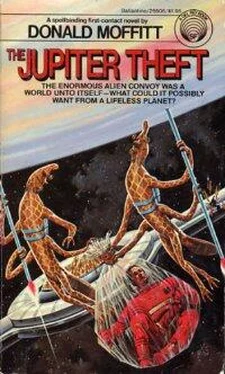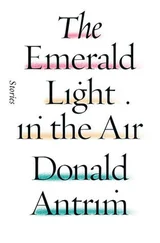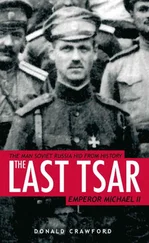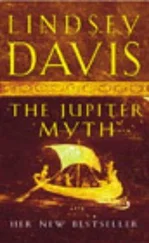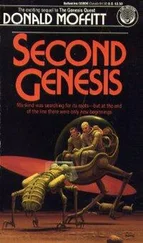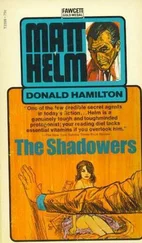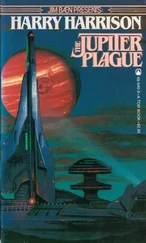He took a closer squint at the cascade of repeated shapes frozen on the screens. There! He could make it out! A plume of light sprouting from the waist of the ship, driving it inward toward its primary.
He shuddered. What was that spray of light? A waste product of the drive, as heat is the byproduct of the work done by a mechanical engine? He suspected that the Cygnan exhaust was something akin to pure gamma rays. It wouldn’t do to let that stuff get too close to an inhabited planet, to say nothing of that terrible bow wave!
“How will you remain in the shadow of the light-that-kills?” he asked impulsively, improvising words and hoping his meaning was getting across.
The two of them twittered happily. They were proud of their puppy. It had done another trick.
Tetrachord plucked at the console, wiping the viewscreens. The picture was replaced by a triptych of bright toylike geometric shapes rotating and counter-rotating in intricate patterns like the mechanism of a transparent clock. The moving parts ticked away in tiny jumps in sequence around the three identical screens.
A model of their system! Here was a planetarium for Cygnan schoolchildren, showing them how their convoy of artificial worldlets traveled through space! He’d hit the jackpot again. He didn’t need any math to grasp the basics of what was being shown to him.
At the center was a glowing red ball, moving against an abstract background of stars. That was the gas giant. The one they had already used up, soon to be replaced by Jupiter. Around its waist was a string of tiny chips that pulsed in sequence to indicate motion. An abstraction of the robot probe, tailored to Cygnan perceptions. He squinted more closely. On one of the three screens he could see a fan of light directed outward—the lethal spray of radiation.
Enclosing the two-body system in a wider, polar orbit was a smaller sphere of opalescent gray. One of the gas giant’s moons, dragged along by its kidnapped parent. It rotated in a plane that was almost vertical to the loop described by the probe. It put Jameson in mind of a gyroscope configuration, or perhaps one of the simplified representations of an atom that used to be popular in his schoolboy days. Then, in orbit around the moon—again in another plane—he saw five glittering mites, three-armed asterisks spinning on stems. The Cygnan ships.
The ships, in turn, were rotating around a common center of gravity, chasing one another around in a circle. It was the system of five ships, considered as a single body, that rotated around the moon.
It was beautiful.
He sat watching the show, transfixed, like a boy mesmerized by a complicated set of electric trains. Everything had its own motion. Nothing collided.
He watched it for a long time to be sure how it meshed.
To keep from being flung into space, the little probe, that-which-pulls, had to keep blowing off energy all the time the intricate procession was traveling, even when it had stopped accelerating. It was a worm, draining away the substance of the planet. There could be no such thing as coasting without consuming fuel.
The Cygnans would have to drop in periodically on star systems close to their line of flight to refuel. Otherwise they would find themselves without enough mass to brake and be doomed to go flying forever through the universe.
How many stars had they plundered of gas giants during their long hegira?
Each shanghaied planet, of course, would have cost the Cygnans at least a year’s braking time, plus another year to boost up to relativistic speeds again. For the rest of it, how long would it have taken, ship’s time, to travel the 10,000 light-years that Ruiz had postulated? At 98 percent of the speed of light, Jameson knew, the time-dilation effect would be approximately fivefold. The Cygnans had been cooped up in their triangular cans for more than two thousand years of subjective time. They had managed to maintain a technological civilization, but he guessed things were getting a little stale.
Triad was tootling at him. “Does Jameson see how we are always in the shadow of the moon?”
Jameson returned his attention to the screens. He tried to keep track of the separate motions.
The pilfered moon, despite appearances, wasn’t revolving around its parent. It was orbiting around the common center of gravity shared by the gas giant and the probe that was in tight orbit around it. But since the center of gravity was so close to the planet’s surface, of course, it made no practical difference to what he was seeing.
The moon, from his point of view above the system, was rotating counterclockwise around the gas planet. The direction of motion of the whole system was upward, toward twelve o’clock. The mitelike ships, in orbit around the moon, were traveling clockwise.
Their orbit had the same period as the moon’s orbit around its primary. They were always in a trailing position, shielded from impact with interstellar hydrogen by three thousand miles of rock. At every point of the opposing orbits, the ships were in the lee of the radiation.
He watched the clockwork simplicity of it.
With the moon in six-o’clock position, the rosette of ships was also in six o’clock in its elliptical lunar orbit. It was shielded by both the moon and the bulk of the giant planet itself.
When the moon emerged from that cone of safety, to three-o’clock position, the ships were at the moon’s nine o’clock. But since the moon was by that time tilting its twelve inward toward the giant, the ships were still in a trailing position. With the moon at twelve o’clock, leading the whole procession, the cluster of ships was safely behind it, at the moon’s twelve o’clock. Another quarter turn for both orbiting systems put the moon at nine and the ships at three—still in the moon’s radiation shadow.
The ships’ orbits, he suspected, would have to be adjusted continually to match their period to the moon’s rotation—especially as the mass of the primary shrank. But surely, maneuvering the five ships would require only a fraction of the total energy expenditure eaten up by moving a Jovian or superjovian!
It was beautifully simple and elegant! Jameson watched in admiration for long moments.
Even the deadly probe, with its radiation backlash, was never at the crossroads of the moon’s orbit at the two points where their paths intersected. Everything ticked along beautifully.
“I see,” Jameson said. “Your ships are safe.”
The two Cygnans whistled their approval. Tetrachord wiped the screens and dropped down on four legs. One of his upper limbs twined around Triad in an almost-human gesture of affection.
Jameson blared the sharp fanfare for attention. Startled, the Cygnans jerked their heads in his direction.
“What about Earth? My planet. Will it be safe when you leave this system?”
Consternation. Much twittering back and forth. Jameson had the impression that they had never thought about it, that it hadn’t occurred to them to care.
Finally Tetrachord punched in an inquiry to the ship’s computer, or whatever passed for one aboard the Cygnan vessel. There were flashing images that made no sense to Jameson. They hadn’t bothered to adjust the screen for human vision this time.
Tetrachord twisted around. His eyestalks stretched like taffy in Jameson’s direction.
“Jameson,” the creature said. “We will cross the orbit of your planet when we leave. We will pass close to your sun and swing around it to change direction.”
Jameson got a crawly sensation down his spine. The Cygnan caravan would cross the Earth’s orbit twice.
“Just how close to Earth will you pass?” he asked.
There was no answer for a while. Jameson found he was holding his breath.
Читать дальше
